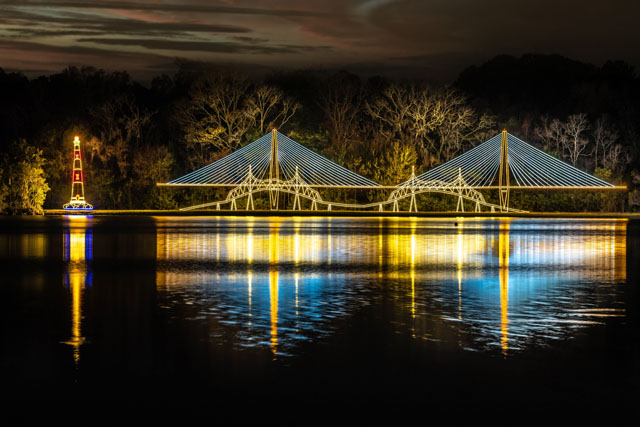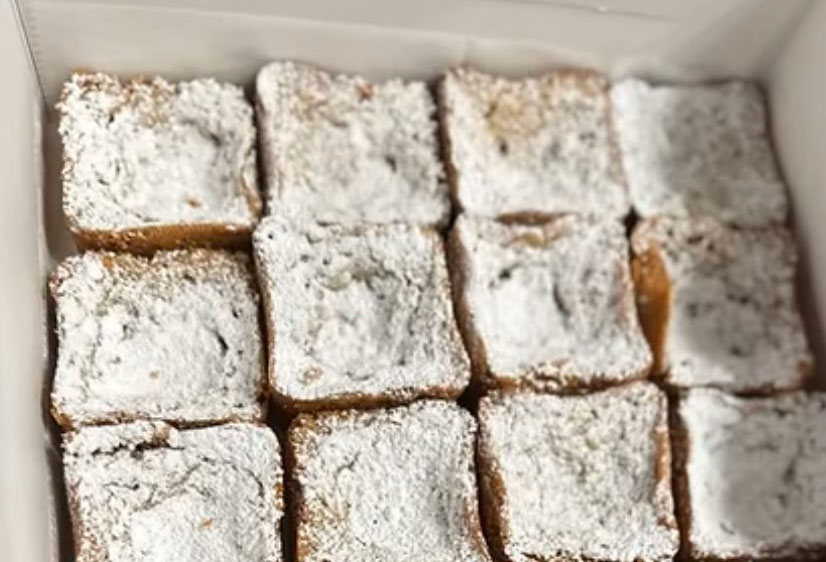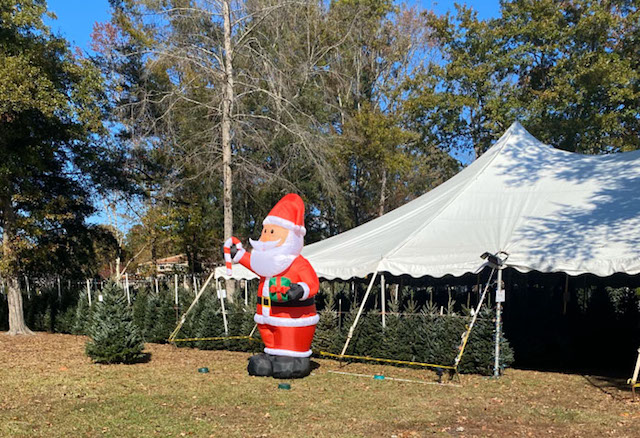History Illuminated
02 Nov 2024
Walk through James Island history through Holiday of Lights displays
By Tim Lowry

"Christmas light looking" is a beloved modern tradition all across the United States. In the South Carolina Lowcountry, the Holiday Festival of Lights at James Island County Park is a beloved annual tradition. This year, the festival starts on November 10 and is open nightly from 5:30 - 10 p.m. through December 31. Since 1990, more than five million people have visited this holiday hotspot with over two million lights illuminating displays that depict everything from prehistoric animals and Charleston landmarks to traditional Christmas tableaus. There are also opportunities for gift shopping, train and carousel rides, sand sculpture viewing, enchanted nature trail walks, s'mores around the campfire and much more!
However, the great majority of people traveling through this illuminated winter wonderland know little about the specific history of the area. Here are a few stories that cast long shadows across the lit up landscape of James Island.
Because the Holiday Festival of Lights begins before Thanksgiving, there is usually a depiction of Pilgrims and Indians. The first James Islanders were a semi-nomadic group of Indians who used the area for spring fishing and summer farming. It is thought that the local tribe raised fields of corn and perhaps also peaches and tobacco. We cannot be certain, but peaches may have been introduced by Spanish explorers who visited James Island as early as 1609 and who called the local population the "Ostano" people.
What is more well documented is the devastating effect from the introduction of European diseases, which caused rapid population decline. In fact, when the English began settling the area after 1670, the Ostano or "Stono" population had dwindled to a very small group of probably 50-70 souls. When the English introduced pigs and cattle to James Island, the natives began hunting the settlers' livestock. This caused a good bit of tension between the two groups and by the spring of 1684, the Indians had moved off the island. Today, the river flowing past James Island County Park is named for this indigenous group and is really the only remembrance of their time and culture.
There is more than one light display that depicts seafaring vessels related to Charleston's maritime history. Of course, in a child's mind, a masted sailing vessel can only mean one thing: Pirates! It is said that James Island was originally called Boone's Island. One of the earliest landowners, Mr. John Boone, was sanctioned by local authorities in 1691 for allegedly consorting with scurvy sea dogs. There is also speculation that a mariner named Jonathan Evans renounced his "wicked ‘pyractycall’ (pirate call) course of life" and settled down to run a plantation on the island about the year 1701 after receiving a royal pardon for his association with the notorious pirate Captain William Kidd.
Some of the light displays are animated and depict plants growing taller and taller before finally bursting into beautiful blossoming flowers. These whimsical scenes can serve as a reminder of the crops that were cultivated for three centuries on James Island.
Eliza Lucas Pinckney began experimenting with the indigo plant at Wappoo Plantation around 1740 and was producing the distinctive indigo blue dye by 1744. Rice was also cultivated for a time, but after the invention of the cotton gin, James Island became world famous for its production of sea island cotton. An 1860 inventory notes that in that year, a local island property produced nearly seven tons of ginned cotton plus 1,200 bushels of corn, 200 pounds of wool, 100 bushels of peas and beans, 800 bushels of sweet potatoes, 500 pounds of butter and twelve tons of hay.
Lighted toy soldiers in their bright red coats represent the thousands of British troops that landed on James Island in 1780 during a military siege that resulted in the occupation of the City of Charleston.
It was at Christmas time two years later in 1782 when the red coats would finally vacate the Holy City. Some of those foreign soldiers noted that the island was infested with venomous snakes, pesky mosquitoes and ravenous wolves. The alligators in that day were of exceptional size, measuring 16 feet! This beloved swamp monster is depicted in a humorous light display where a Christmas elf learns to be wary of his chomping jaws!
The British Red Coats are not the only military represented in the festival of lights. There is also a large animated display representing a Civil War cannon barrage on Fort Sumter. The effect is somewhat quaint and we are very glad to have that great upheaval behind us. But it should not be forgotten that there were many Civil War actions that took place on James Island, including the Battle of Seccessionville and events that led to the storming of Battery Wagner as depicted in the Academy award winning film Glory featuring the heroic efforts of the 54th Massachusetts Infantry Regiment and starring Matthew Broderick, Denzel Washington and Morgan Freeman.
Finally, there are several light displays featuring the architecture of the South Carolina Lowcountry: historic homes, churches, and public buildings. In other words, they depict community. It should be noted that the most enduring communities of James Island were maintained by enslaved African families and their descendants that worked the land.
From the earliest plantation times until today, the Geechee/Gullah culture, which is so deeply rooted in African language and tradition, has always been a defining feature of island life. During Reconstruction, large plantations were divided and apportioned to black families who established vibrant communities with churches, general stores, barber shops, ice cream parlors, recreational areas and even a popular golf course. These cultural establishments, though fewer in number due to rapid population growth and development, still endure and the Geechee/Gullah culture is more and more valued by locals and visitors alike.
To borrow a phrase from a popular Christmas song, the Holiday Festival of Lights provides us with many "tales of the glories of Christmases long, long ago." The glowing luminaries remind us of what is past and what must be preserved through the many stories that will be told at this "most wonderful time of the year."
Storyteller Tim Lowry is a Southern raconteur from Summerville. Learn more at www.storytellertimlowry.com.











